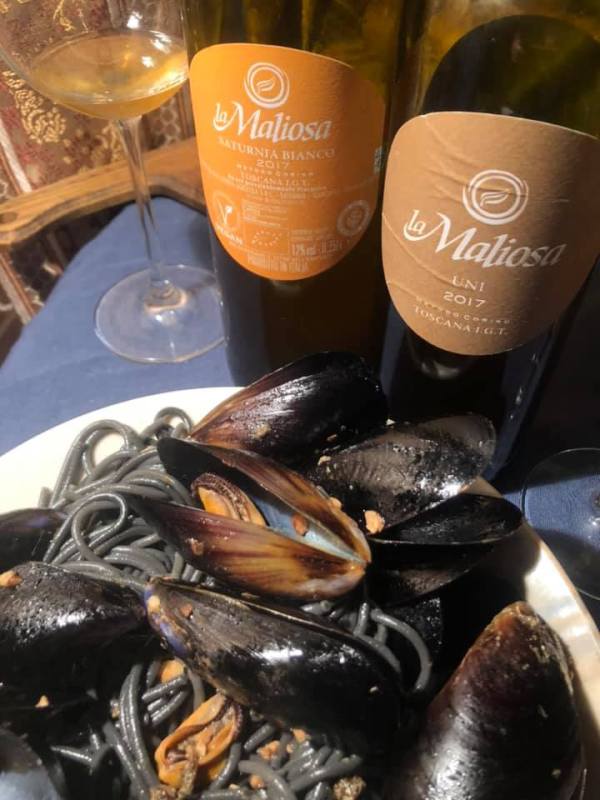
La Maliosa orange wines using indigenous grapes, native yeasts, biodynamics paired with fresh Santa Barbara mussels and shrimp on squid ink pasta
When is a wine certified organic and biodynamic but not?
When it meets certification in its country of origin and other places in the world but not in the US where I live!
As the host of this month’s Italian Food Wine Travel Group’s virtual excursion into biodynamic wine of Italy, I figured I’d be able to acquire the wines no problem. Read the invite here and the preview post here.
I started a while ago, checking the samples I had around, but none had that tell-tale Demeter logo:

So I responded to a pitch asking if any of the wines were biodynamic, and when I got a yes, I was quite relieved, and I didn’t worry about buying or finding biodynamic wines; I had mine coming.
But when they arrived, no such luck: the three from Valle Real were certified organic not certified biodynamic. While I’ll write about those wines soon — thinking Earth Month in April — I was still on the lookout for certified biodynamic Italian wines so I asked a friend in the business if he could help: YES! He got me a sample of a wine he was sure was biodynamic but again on further investigation, the Volpaia Citto, a more international style, announces that it is organic on the label but only in the Italian part of the website did I learn that only some of the grapes are certified as biodynamic — and not likely these — but I wrote about it anyway in the preview.
Next I went to LA’s Silver Lake Wine, certain they could help me. But no! More on that story here.
So when I met Sheila Donahue at Vinitaly’s Italian Wine Ambassador course, learned she’s importing wine from Italy with a business based out of my town of Ventura, AND she had a few BIODYNAMIC wines made by a woman making it perfect for Women’s History Month, I was sure once again I was set.
But once again, while these wines are certified biodynamic and organic in much of the world, La Maliosa had to take the certification off the label for US import because they don’t meet official US standards.
I can only imagine the choice words in Italian that La Maliosa founder, farmer, and winemaker Antonella Manuli had to say when Sheila had to break this news to her!
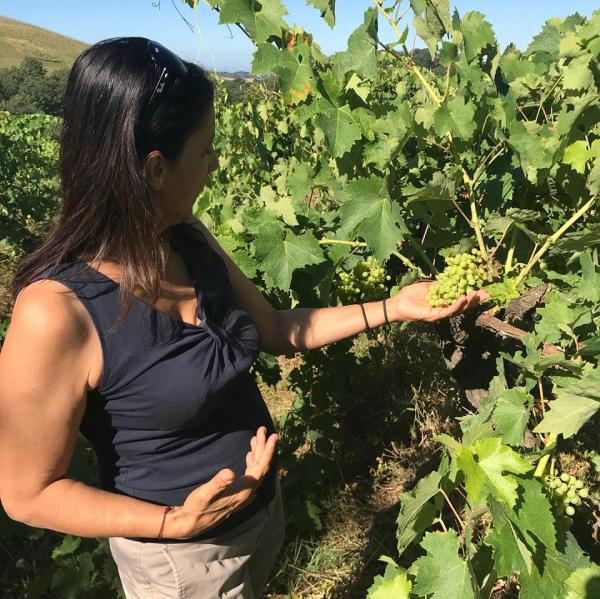
La Maliosa founder, farmer, and winemaker Antonella Manuli in the vineyard; photo by importer Sheila Donohue
La Maliosa is proud to proclaim that they use an “totally vegetable based biodynamic way of farming” as Sheila put it.
Further, the label states that Antonella Manuli uses the “Metodo Corino” method. According to Sheila, Lorenzo Corino developed The Corino Method, – which is a belief very close to biodynamics, the ecosystem which at times is complex and at others quite simple but a belief that as a grower we are stewards of the land. They don’t use fertilizer or pesticides, because they want to create an environment where the vines become strong on their own.
When Antonella Manuli decided to make wine, she looked for property in the Saturnia area because she wanted to produce wines and olive oil done in the old ways, as close to nature and non-manipulation as possible, and she found a 60 year old vineyard with procanico growing. They don’t really train their vines; it is very wildly grown on her 160 hectares altogether where she makes less than 20,000 bottles per year.
Let’s now turn to two of Antonella Manuli’s La Maliosa wines:
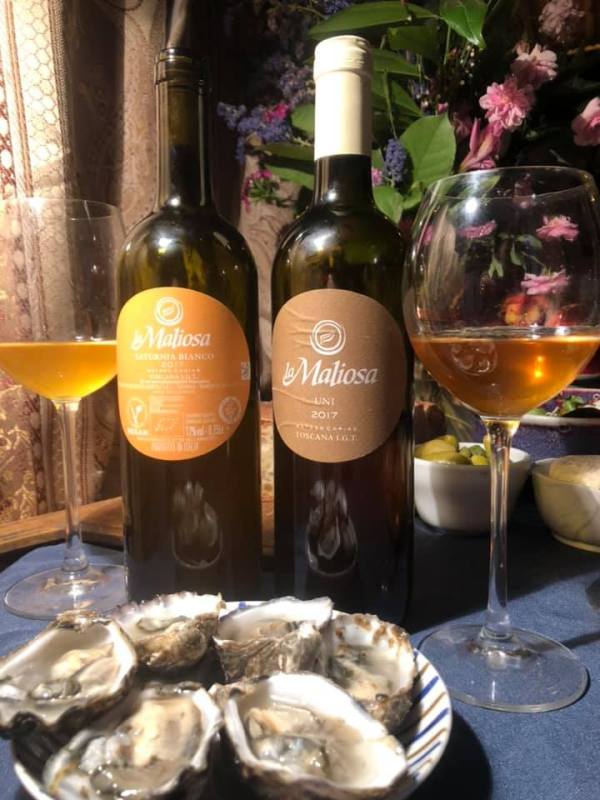
2017 – La Maliosa – Saturnia Bianco – 12% alcohol – SRP under $30
2017 – La Maliosa – Uni – 12.5% alcohol – less than $45
Menu
Organic tomato and field green salad with Sue’s simple vinegarette: finely chop 1 to 2 cloves of garlic and two to 3 tablespoons fresh basil, add to 1/3 cup extra virgin olive oil, add a pinch of salt and freshly ground pepper, stir in 1/4 cup aged balsamic vinegar while whisking; optional– 1/2 teaspoon of mustard to oil and vinegar bind and thicken).
Pasta Bar
We prepared two kinds of pastas and tossed them with:
- Nasturtium pesto on organic penne pasta; Just follow your favorite pesto recipe and substitute nasturtium leaves which are prolific in my garden this time of year! You can also combine some basil with the nasturtium leaves. Yum! We toasted the pine nuts and I really like the richer flavor with the peppery nasturtium leaves.
- Bolognese (we bought ours from a favorite Italian restaurant, Ferraros) on organic penne pasta
- Fresh Santa Barbara Mussels and Shrimp on organic squid ink pasta; we would have included Jolly Oyster clams but they were sold out! So easy and so good!
- Pasta con Ricci (Uni or sea urchin roe): Santa Babara Uni on organic squid ink pasta; Sue adapted several recipes to our ingredients and my palate but the key idea is seeing it simple to showcase the uni (we didn’t use shallots of garlic), blending some of the uni with butter and not cooking it, just letting the hot pasta melt it; we will be making this again! Absolutely a new favorite! And so easy!
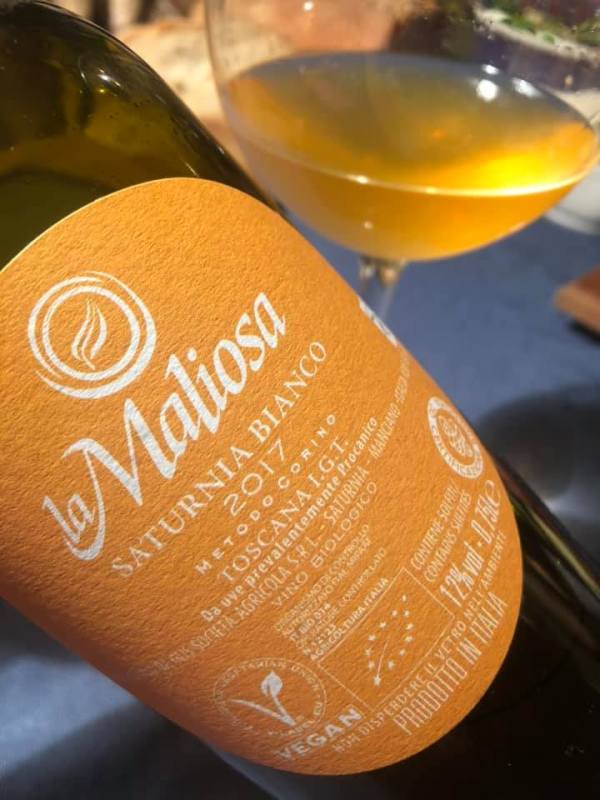
2017 – La Maliosa – Saturnia Bianco – 12% alcohol – SRP under $30
Blend of indigenous Italian grapes, primarily procanico.
Serve these unfiltered wines at a temperature above regular white wines, closer to cellar temperature.
The leaf on the logo give a sense of the importance of the land.
Color: Very cloudy, light orange or golden, similar to the color of the label or even a good beer, apricot juice
Nose: Lots of yeasty funk on the nose, not much fruit, some apricot, not many florals either, sulphuric, it is not as inviting or as engaging as some wines, but it will pique your interest with lemon, cardomom and cloves. You have to hang out with the wine for a while to get it.
This wine is very much a living organism and will change as opened or even over time.
Palate: Tropical fruit like mango, banana, and pineapple, some apricot almost like fresh apricots cooked in a pie with cinnamon that aren’t stewed, but roasted in the oven. There is lots of acidity on the back end, it is a bit drying on the tip of the tongue. Lovely yeasty bready quality.
This wine is really interesting and different than anything you may have ever tasted; it is very complex. The lees being left on these wines gives them such a lovely textural feeling.
Pairing: Very nice with the creamy La Tur. Likes the salad, the richness of the pine nuts and the garlic in the dressing made this wine pop. The oysters weren’t our favorite with either of these two wines. Oysters need more of a super clean wine. The uni has a wonderful umami — the uni pasta with the uni wine was a wow moment. Simple ingredients in the salad with the fresh mozzarella, tomatoes, pine nuts, fresh garden greens and simple balsamic vinegarette works wonderfully.
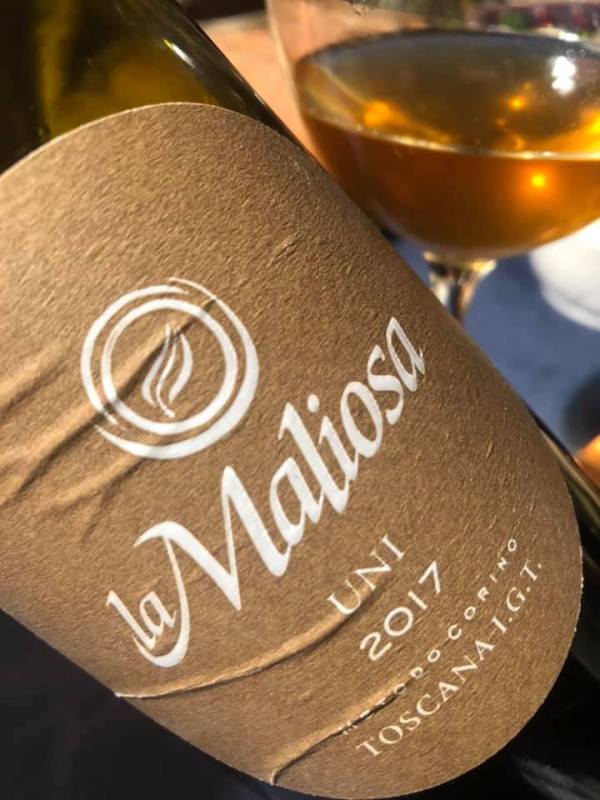
2017 – La Maliosa – Uni – 12.5% alcohol – less than $45
100% procanico, these grapes are also hand selected and given a soft press, the grapes are destemmed and fermented with local native yeasts, wooden barrels 5 to 6 months.
Color: Deeply huged golden, like a nice beer, unfiltered but not as cloudy as the other, on the orange side of golden.
Nose: Sulphur, apricots, kind of like dried apricots that have been preserved with sulphur. Sue got tropical fruit like banana, and I got some nutmeg. Though predominately sulphur, a dash of saffron is present.
Palate: This wine is very fruit forward, possibly a bit more residual sugar? Shelia felt this wine could age because of the tannins, and she also felt this could go with red meat because of the tannins.
Pairing: The La Tur cheese brought out the tropical fruit in the wine. The fresh tomatoes in the salad were so nicely sweet, which went so well with this very fruit forward wine. The simplicity of the salad nicely showcased the complexity of the wine. It loved the freshness of the nasturshium pesto. With the pasta and mussels, there was such a creaminess with the wine, there was not a drop of cream in the sauce, but there was an amazing creamy mouthfeel. This wine also holds up to a bolognese sauce bearing out the prediction that is a white wine that would work with meat. I would have loved to have experimented further with this wine like we usually do but Sheila needed to take the wines with her to share with potential clients.
La Maliosa also has red wines using indigenous varieties and biodynamic Metodo Corino. Look for these wines coming soon to a wine shop near you or request them from Verovino wines.
This Saturday, the Italian Food Wine Travel group of influential bloggers are investigating Italian Viticulture; we will post our blogs by 8am, and from 8-9am we’ll be discussing what we learned on twitter using the hashtag #ItalianFWT. Read the invitation post here.
-
-
- Jill Barth of L’Occasion: “Gravner: ‘Nature As A Source Of Thought’“
- Camilla M. Mann: “Dinner in Testosterone Land: Braised Short Ribs + 2016 Nuova Cappelletta Barbera del Monferrato” on Culinary Adventures with Camilla
- Wendy Klik: “Brasato al Vino Rosso with Montefalco” on A Day in the Life on the Farm
- Jeff Burrows: “Looking Beyond Biodynamic Certification at Cantina di Filippo” at Food Wine Click!
- Lauren Walsh, The Swirling Dervish: “The Wines of Alois Lageder: Cultivating Nature as a Habitat of Life.”
- Nicole Ruiz Hudson is Cooking to the Wine: “Arianna Occhipinti SP68 Sicilia Rosso with Creamy Eggplant and Tomato Zoodles”
- Jennifer Gentile Martin: “The Organic Wines of Abruzzo with La Valentina” on Vino Travels.
- Susannah Gold of Avvinare: “Chianti without sulfites- the wines of Fattoria Lavacchio”
- David Crowley of Cooking Chat: “Mushroom and Short Rib Ragu with Sono Montenidoli”
- Lynne Gowdy of Savor the Harvest: The Important Thing You Don’t Know About Italian Wine Labels
- Host Gwendolyn Alley the Wine Predator: “La Maliosa Biodynamic Procanico and a Pasta Bar with Uni and Mussels“
-
- January: Camilla M. Mann, Italian Wines for Cold Winter Nights
- February: Jeff Burrows, Umbria, with a focus on Sagrantino
- March 2: I’m hosting Biodynamic Wines
- April: Jason Or Jill Barth, Island Wines of Italy
- May: Lynn Gowdy Marche and the Pecorino grape
- June: Katarina Andersson Lambrusco? or other
- July: Camilla M. Mann – Lazio Wines
- August: Kevin Gagnon Whites of Northeastern Italy
- September – Jennifer Gentile Martin Passito Wines
- October – David Crowley Abruzzo
- November: Wendy Klik, Outside the Norm of Chianti in Tuscany (Montecucco, Bolgheri, Maremma, Valdarno di Sopra)
- December: Susannah Gold Lesser Known Wine Regions of Italy (Molise, Basilicata, etc)





What a fun discussion, thanks for hosting this month! I love digging in to find the stories behind the headlines.
LikeLiked by 1 person
You’re welcome! Thank you for participating — you always have so much to offer! and I’m glad you enjoyed it!
LikeLike
Pingback: Looking Beyond Biodynamic Certification at Cantina di Filippo #ItalianFWT | foodwineclick
The certifications are tricky. I have a post yet to go up on the topic, but I admittedly don’t get hung up on them. The store I work at focuses on small producers, and the majority of the wines fall on the sustainable/organic/biodynamic/natural spectrum but you might not know it if you looked only for the certification logos on the bottles. As small producers, they run into a lot of hurdles in getting certified.
LikeLiked by 2 people
Wow. Super interesting. Learned another aspect to biodynamics I did not know. Thanks for sharing, Gwen.
LikeLiked by 1 person
Yes, it is a fascinating topic and I love that there’s a vegetarian version of biodynamics– I look forward to learning more and trying more of these wines! Thanks for stopping by and commenting!
LikeLiked by 1 person
I think Lynn is right, the only way to find out is by researching each individual winery because, as you point out, the label certification is no guarantee.
LikeLiked by 1 person
Well as always the people who do their homework get the A — and in this case, the A+ certified wines! But that takes time and so many of us are so busy…
LikeLike
Pingback: Dancin’ In the Moonlight? Biodynamic Wines of the World #WinePW Invite and Bonterra Reds With Braised Beef | wine predator
The UNI looks like a delicious golden honey. Nice article.
LikeLiked by 1 person
It’s truly amazing the difficulties of knowing all the specifics about a bottle of Italian wine. And I think this probably holds true for other countries as well. Good thing- you have a new source for Italian wines in Ventura who can give you more details on each bottle? And I now know about Corino Method, thank you!
LikeLiked by 1 person
Yes the Corino Method is a fascinating response to biodynamics for vegetarians so I’m really glad I changed the theme!
LikeLike
Pingback: Mushroom and Short Rib Ragu with Sono Montenidoli #ItalianFWT | Cooking Chat